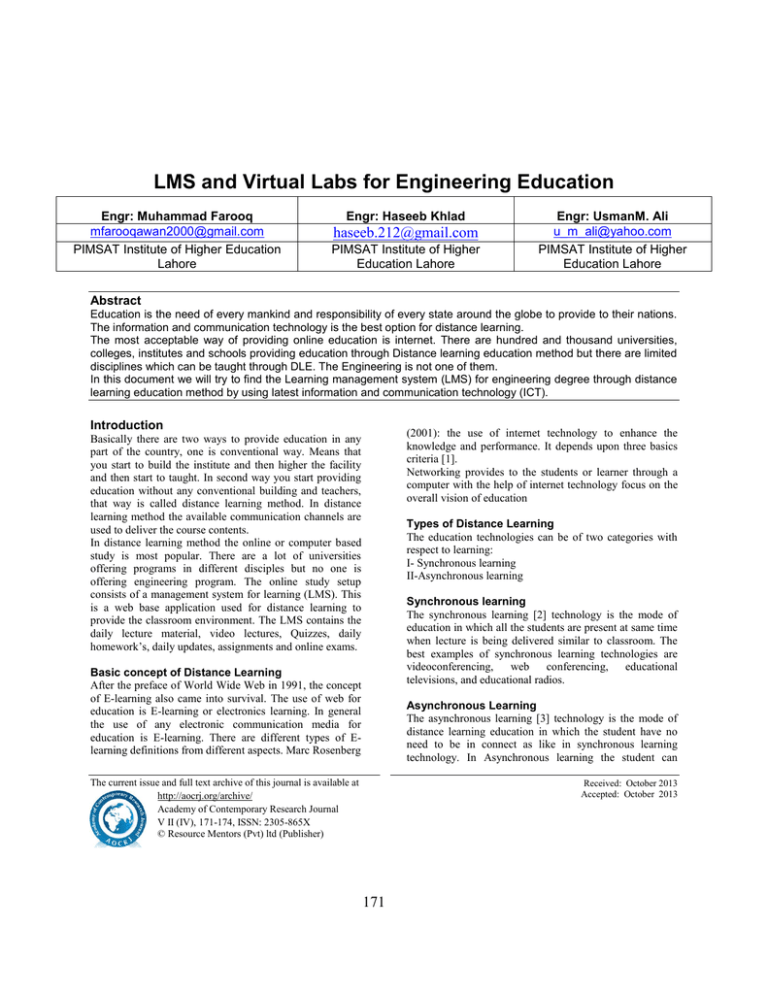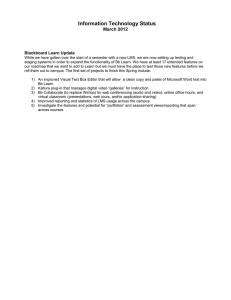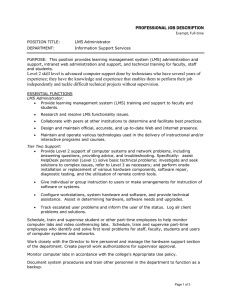LMS and Virtual Labs for Engineering Education
advertisement

LMS and Virtual Labs for Engineering Education Engr: Muhammad Farooq mfarooqawan2000@gmail.com PIMSAT Institute of Higher Education Lahore Engr: Haseeb Khlad haseeb.212@gmail.com PIMSAT Institute of Higher Education Lahore Engr: UsmanM. Ali u_m_ali@yahoo.com PIMSAT Institute of Higher Education Lahore Abstract Education is the need of every mankind and responsibility of every state around the globe to provide to their nations. The information and communication technology is the best option for distance learning. The most acceptable way of providing online education is internet. There are hundred and thousand universities, colleges, institutes and schools providing education through Distance learning education method but there are limited disciplines which can be taught through DLE. The Engineering is not one of them. In this document we will try to find the Learning management system (LMS) for engineering degree through distance learning education method by using latest information and communication technology (ICT). Introduction (2001): the use of internet technology to enhance the knowledge and performance. It depends upon three basics criteria [1]. Networking provides to the students or learner through a computer with the help of internet technology focus on the overall vision of education Basically there are two ways to provide education in any part of the country, one is conventional way. Means that you start to build the institute and then higher the facility and then start to taught. In second way you start providing education without any conventional building and teachers, that way is called distance learning method. In distance learning method the available communication channels are used to deliver the course contents. In distance learning method the online or computer based study is most popular. There are a lot of universities offering programs in different disciples but no one is offering engineering program. The online study setup consists of a management system for learning (LMS). This is a web base application used for distance learning to provide the classroom environment. The LMS contains the daily lecture material, video lectures, Quizzes, daily homework’s, daily updates, assignments and online exams. Types of Distance Learning The education technologies can be of two categories with respect to learning: I- Synchronous learning II-Asynchronous learning Synchronous learning The synchronous learning [2] technology is the mode of education in which all the students are present at same time when lecture is being delivered similar to classroom. The best examples of synchronous learning technologies are videoconferencing, web conferencing, educational televisions, and educational radios. Basic concept of Distance Learning After the preface of World Wide Web in 1991, the concept of E-learning also came into survival. The use of web for education is E-learning or electronics learning. In general the use of any electronic communication media for education is E-learning. There are different types of Elearning definitions from different aspects. Marc Rosenberg Asynchronous Learning The asynchronous learning [3] technology is the mode of distance learning education in which the student have no need to be in connect as like in synchronous learning technology. In Asynchronous learning the student can The current issue and full text archive of this journal is available at http://aocrj.org/archive/ Academy of Contemporary Research Journal V II (IV), 171-174, ISSN: 2305-865X © Resource Mentors (Pvt) ltd (Publisher) Received: October 2013 Accepted: October 2013 171 Role of Justice in the Complaint Handling Setting: ScenarioBased Experiment Stud Engr: Muhammad Farooq Engr: Haseeb Khlad Engr: UsmanM. Ali Academ of Contemporary Research Journal Volume II, Issue IV, 2013, 171 -174 access the study material at anytime, anywhere. The printing material mailing is old examples while email, voice mail, recorded video lectures, and SMS are the latest examples. The maximum utilization of mobile computing is in asynchronous learning technology. On bases of Technology the distance learning education can be categorized as following; Synchronous Learning Technologies Asynchronous Learning Technologies Synchronous Learning Technologies The most ordinary Media used for Synchronous Learning are educational television channels and radio channels. Synchronous learning technologies are videoconferencing, web conferencing, educational televisions, and educational radios. As mostly universities used Radio broadcasting for Mass communication department. The only one university in Pakistan, Virtual University used Television broadcasting for education. Concept of Virtual labs A virtual laboratory or v-lab is an online platform where the learner interacts with an experiment or activity which is essentially isolated from the learner or which has no instant physical reality [9]. This is very helpful to create an environment for this virtual learning engineering program to provide the hand on labs experiments. The idea of virtual labs is already in use by different online courses or training. The best examples of virtual labs are CISCO online training courses. MIT also introduce some online courses which contains this type of labs. For the distance learning engineering program the best platform is Indian Institute of Technology (IIT) which provides the all facilities of lab experiments through Virtual labs in different fields of engineering programs. For the distance education only few programs can conducted while all other engineering, medical and applied sciences are not possible due to the laborites, these programs are required the hand on physical lab work. The latest information & communication technology solve this problem. For the distance learning institutes it is very to provide engineering education with the help of virtual lab. The limitation of lab access can be overcome by utilization latest communication technology. Now every student anywhere any time can enjoy equal resources [10]. A synchronous learning technology In this way of learning the student can study anywhere any time. This can be called E- leaning or online learning. For this type of learning there are some tools used, the student requires internet, computer, CD/DVD player etc. Concept of Learning Management System When we discussed about the distance learning education in this age of technology the mostly used technology for online or e-learning is Learning Management System LMS. The LMS is a web base tool used for online study. The LMS is web based application with completely classroom environment. The LMS consists of learning documents, Video lectures, software tools including, online quizzes, online assignments and online examination. LMS provides some options to student, to check the daily updates, quizzes results, assignment marks, and group discussion etc. At administration side the authorities can track and help the student on time through software checks. The administration also provides extra help to student with online interaction and can jugged their student’s weak areas of studies. Objectives of the Virtual Labs To provide remote-access to Labs in various disciplines of Science and Engineering. These Virtual Labs would cater to students at the undergraduate level, post graduate level as well as to research scholars. To enthuse students to conduct experiments by arousing their curiosity. This would help them in learning basic and advanced concepts through remote experimentation. To provide a complete Learning Management System around the Virtual Labs where the students can avail the various tools for learning, including additional web-resources, video-lectures, animated demonstrations and self-evaluation. To share costly equipment and resources, which are otherwise available to limited number of users due to constraints on time and geographical distances [9]. Advantages of LMS The advantages of LMS are as below, [6] 1. Centralized Learning 2. fallowing and covering for improved Performance 3. ability to Evaluation urgently 4. simple Up gradation of Content, material Information to maintain the flow of E-learning in commercial Organizations and learning Institutes 5. LMS – Simplify Learning Process Standards Use in LMS For LMS there are some standards developed. Some most important and common standards are given below. IML is an international standard for learning contents, which is developed by the global learning consortium. This standard deals with the reuse of eLearning contents [7]. http://www.adlnet.gov/scorm/index.cfm SCORM For web eLearning, this is the combination of some standards and specifications which deal with the communication between the student access sides and LMS host system sides, called run-time environment [8]. IMS QTI This standard has also developed by global learning consortium. This standard is for data modeling for the demonstration of question and test/ Quiz data and its results. IMS Types of virtual labs 172 Role of Justice in the Complaint Handling Setting: ScenarioBased Experiment Stud Engr: Muhammad Farooq Engr: Haseeb Khlad Engr: UsmanM. Ali Academ of Contemporary Research Journal Volume II, Issue IV, 2013, 171 -174 There are most common types of virtual labs as given below, described in different research documents [11]. 1- Software labs 2- Virtual labs 3- Remote web labs programs are must for the student to access the v-lab. There tools are as given below [12]. Flash Java XML VPN Lab VIEW Matlab/ simulink Web2.0 As shown above diagram the internet required to makes a communication link between student side and LMS web server. On the other end of internet there is LMS web server which further contains three different types of servers. 1- LMS web server 2- Data base server 3- V-LAB web server To perform the lab the student must login on LMS and will select his course which he is studying if the course required the lab experiment then he will move to V-LAB but before this he will complete his lecture and daily work like lecture, assignment, quiz etc which contain by data base server. After this he will move to V-LAB web server. Software Lab These types of labs are software based labs which can be installed at student’s computer without internet connection. And student can use these labs at any time anywhere. Main problem in these labs is only that the teacher or instructor cant knew about student lab progress. Virtual Lab Such type of labs is web based simulated labs which must require the arability of internet connection. The student can use these labs at any time anywhere. With these labs the instructor can easily monitor the activity of student. These are not real time labs in which student can’t play with real equipment’s these are just simulation. Remote Web Lab This kind of lab is directly connected with operates and student can perform the on real time experiment at any time anywhere. For this lab student must have internet connection. At same time teacher can view the activity of student and can guide him. Basic Structural of LMS and VLAB When a student moves to LAB according to his course the LMS through him to VLAB web server. The VLAB server provides the LAB environment according to the course of student the VLAB server decide that what type of lab is required for the student course. If the course requirement is only software lab then VLAB web server just send a message that student perform this lab his own computer and just submit his results against the given task. It the course requirement is virtual lab then VLAB web server will open a web based simulated lab is friend of student. And if the requirement of any course is remote web lab then server will connect the student to the lab The above diagram can be integrated into three parts. 1- Student side 2- Internet 3- LMS network side To perform the lab experiment on student side, the student workstation must contain some basic programs. These 173 Role of Justice in the Complaint Handling Setting: ScenarioBased Experiment Stud Engr: Muhammad Farooq Engr: Haseeb Khlad Engr: UsmanM. Ali Academ of Contemporary Research Journal Volume II, Issue IV, 2013, 171 -174 equipment directly and student can performer the lab in real time environment. iv. Conclusion This document describes the basic idea of consolidation of LMS and VLAB for the engineering education through distance learning methodology. The LMS which is commonly used in different institutes and universities for distance learning education. The virtual lab for different type of technical course is already in used for training programs for example CISCO. So this different open universities and institutes can use this idea for further research and can produce more online labs. v. vi. vii. viii. ix. References i. http://nwlink.com/~Donclark/hrd/elearning/define.htm l ii. A study of asynchronous and synchronous e-learning methods discovered that each supports different purposes By Stefan Hrastinski. EDUCAUSE Quarterly, vol. 31, no. 4 October–December 2008. iii. A study of asynchronous and synchronous e-learning methods discovered that each supports different x. xi. xii. 174 purposes By Stefan Hrastinski. EDUCAUSE Quarterly, vol. 31, no. 4 October–December 2008. The Universal Right to Education: Justification, Definition, and Guidelines By Joel H. Spring Distance Education; definition and Glossary of Terms by Lee Ayers Schlosser, Michael Simonsin. http://www.timelesslearntech.com/blog/5-advantagesof-using-the-learning-management-system-lms/ http://www.adlnet.gov/scorm/index.cfm http://www.imsglobal.org/question/ HE VIRTUAL LABORATORY AND INTERACTIVE SCREEN EXPERIMENTS Paul A Hatherly Open University web.phys.ksu.edu/icpe/Publications/teach2/Hatherly.p df http://www.vlab.co.in/ http://www.vlab.co.in/ Xuemin Chen, ,Gangbing Song, Yongpeng Zhang Virtual and Remote Laboratory Development: A Review Earth and Space 2010: Engineering, Science, Construction, and Operations in Challenging Environments © 2010 ASCE




